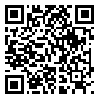Volume 5, Issue 2 (3-2018)
jbrms 2018, 5(2): 39-47 |
Back to browse issues page
Download citation:
BibTeX | RIS | EndNote | Medlars | ProCite | Reference Manager | RefWorks
Send citation to:



BibTeX | RIS | EndNote | Medlars | ProCite | Reference Manager | RefWorks
Send citation to:
Raghibdoust S, Sobati E, Shaghaghi V. Theory of mind and its neural mechanisms: A case study of Kurdish-Persian congenitally blind children in Ilam city. jbrms 2018; 5 (2) :39-47
URL: http://jbrms.medilam.ac.ir/article-1-350-en.html
URL: http://jbrms.medilam.ac.ir/article-1-350-en.html
Department of General Linguistics, Faculty of Literature and Foreign Languages, Allameh Tabataba'i University, Tehran, Iran , neishabour@hotmail.com
Abstract: (6550 Views)
Introduction: Theory of mind is one of the most important aspects of cognitive faculty. The theory of mind is impaired in individuals who suffer from mental disorders like autistic children. The ‘autistic-like’ behaviors also have been reported in the congenitally blind children. This study was conducted to examine the presence or absence of theory of mind and its function in congenitally blind children.
Materials and methods: A number of 20 individuals containing 10 bilingual congenitally blind children from Baghcheban elementary school of Ilam city as a case group and 10 sighted ones as a control group were selected. Three kinds of false belief cognitive tests appropriate for the congenitally blind children were designed. The collected data were analyzed using one sample Kolmogorov–Smirnov test, independent t-test along with Levenn test and one-way and two-way Analysis of Variance.
Results: Considering the performance of congenitally blind children in false belief tasks, the blindness just had effect on the story narration task (P<0.05(, while it did not have any effect on the two other tasks. The same performance of the male and female subjects indicated that gender did not have any impact on the development of the theory of mind (P>0.05).
Conclusion: The findings showed only the story narration task was affected by blindness, because this task was more dependent on visual sense. Therefore, blindness results in delay in evolution of theory of mind. To fix this delay, the congenitally blind children should be exposed to further tactile and olfactory inputs.
Materials and methods: A number of 20 individuals containing 10 bilingual congenitally blind children from Baghcheban elementary school of Ilam city as a case group and 10 sighted ones as a control group were selected. Three kinds of false belief cognitive tests appropriate for the congenitally blind children were designed. The collected data were analyzed using one sample Kolmogorov–Smirnov test, independent t-test along with Levenn test and one-way and two-way Analysis of Variance.
Results: Considering the performance of congenitally blind children in false belief tasks, the blindness just had effect on the story narration task (P<0.05(, while it did not have any effect on the two other tasks. The same performance of the male and female subjects indicated that gender did not have any impact on the development of the theory of mind (P>0.05).
Type of Study: Research |
Received: 2017/09/16 | Accepted: 2017/11/17 | Published: 2018/04/9
Received: 2017/09/16 | Accepted: 2017/11/17 | Published: 2018/04/9
Send email to the article author
| Rights and permissions | |
 |
This work is licensed under a Creative Commons Attribution-NonCommercial 4.0 International License. |






